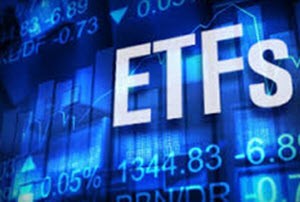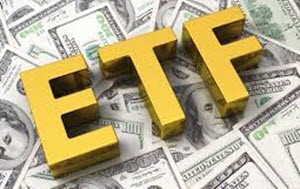What is an ETF?
An exchange traded fund (ETF) is a marketable security that tracks an index, a commodity, bonds, or a basket of assets like an index fund. The ETF owns the underlying asset, which can be almost anything, including gold bars, foreign currency, stocks, or bonds. The ownership of the fund is divided into shares, but shareholders do not have any legal direct claim to the underlying assets. Instead, an EFT shareholder is entitled to a proportion of the profits. If the fund is liquidated, any residual value goes to the shareholders.
 The exact details of how an ETF works will vary from one jurisdictions to another.
The exact details of how an ETF works will vary from one jurisdictions to another.
Examples of well-known exchange traded funds:
- The DIA tracks the Dow Jones Industrial Average Index.
- The Spider (SPY) tracks the S&P 500 Index.
- The QQQ tracks the Nasdaq 100 Index.
- The IWM tracks the Russell 2000 Index.
- The OIH is a sector ETF tracking the oil industry.
- The BBH is a sector ETF tracking the biotech sector.
- The USO is a commodity ETF tracking the commodity price of crude oil.
- The GLD is a commodity ETF tracking the commodity price of gold.
Compared to mutual fund shares, ETF:s tend to have higher liquidity and lower fees. ETF:s trades like common stock on stock exchanges and can be easily bought and sold. Unlike a mutual fund, the EFT will not have its net asset value (NAV) calculated once at the end of every day (but the fund’s underlying holdings are disclosed to the public every day).
It is possible to purchase as little as one share of an ETF. By investing in ETF:s, you can get the diversification of an index fund and at the same time have the ability of selling short and buy on margin. There is a potential for favorable taxation on cash flows, since capital gains from sales inside the fund aren’t passed through shareholders. This is an important distinction between the ETF and the mutual fund.
ETF Creation and Redemption
The supply of ETF shares depends on creation and redemption. Shares are created and redeemed by authorized participants, commonly referred to as APs. Only an entity with really strong financial muscles can become an AP for an ETF. Usually, the APs are banks or investment companies.
Creation occurs when an AP assembles a portfolio of underlying assets and hands that over to the ETF in exchange for newly created EFT shares.
Redemption occurs when an AP return EFT shares to the EFT in exchange for a portfolio of underlying assets.
Inverse ETF
Some ETFs make use of derivative financial instruments to create “inverse ETFs” that will track the opposite return of its underlying assets. It is for instance possible to create a situation where and ETF where the underlying is palladium actually gain when the price of palladium drops.
 Leveraged ETF
Leveraged ETF
By using leverage, the ETF can gain boost its gain from a price change in the underlying.
Example: By using leverage, an ETF where the underlying is platinum can gain 3x for each 1x increase in the price of platinum. Of course, this also means that the ETF risks losing 3x for each 1x decrease in the price of platinum.
The covered-call ETF
So, why do a covered-cal ETF instead of simply buying the underlying, such as stocks or commodities?
Let’s assume that you purchase 100 shares in Apple. You can receive dividend income from your shares, and if you sell a share for more than the purchase price + transaction costs you make a profit this way as well.
The profit from selling the shares isn’t realized until you actually make the sell, but it can still be interesting to follow the daily changes in share price for Apple.
Example:
| Day | Market price per share (in USD) | Market price for 100 shares (in USD) |
| 1 (purchase day) | 113 | 11300 |
| 2 | 114 | 11400 |
| 3 | 116 | 11600 |
| 4 | 115 | 11500 |
| 5 | 118 | 11800 |
| 6 | 117 | 11700 |
| 7 | 120 | 12000 |
| 8 | 122 | 12200 |
| 9 | 123 | 12300 |
| 10 | 124 | 12400 |
As you can see, your investment becomes more valuable as the share price increases. The relation is linear.
Call option
With a call option, the holder of the call option has the right to buy the underlying at a predetermined price on a certain date or dates.
Example: You have a call option that gives you the right (but not the obligation) to purchase 1 Apple share for $110 on May 15, 2016. This means that the exercise price of this call option is $110 per share. When you bought this option, you paid $3 for it.
 On May 15, 2016, you look at the market price for Apple shares and see that it is $120. You decide to use your call option. You purchase 1 Apple share for $110 and immediately sell it for $120. Your gain is $10 – $3 (cost of buying the option) = $7.
On May 15, 2016, you look at the market price for Apple shares and see that it is $120. You decide to use your call option. You purchase 1 Apple share for $110 and immediately sell it for $120. Your gain is $10 – $3 (cost of buying the option) = $7.
(In this example, we have chosen to overlook any transaction costs.)
Today, you usually don’t have to actually carry out the transaction of buying 1 Apple share from the issuer of the call option and then selling that share. Instead, the issuer of the call option will settle by giving you your profit in cash.
Issuing a call option
If you issue a call option without actually owning the underlying shares (that you promise to sell to the option holder), this is called naked selling or naked-call. It is very risky, since you can’t know what the market price of the underlying share will be on the day when the holder of the call option can elects to exercise (use) the option. There is no theoretical limit to how much you can lose.
If you on the other hand issue a call option where you already own the underlying share, you don’t have to purchase this share on the open market on the day when the call option holder exercises the right to purchase the underlying. This is a less risky way of issuing call options and it is called a covered selling or covered-call.
Covered call ETF
A covered call ETF is essentially the same thing as putting together a basket of securities (e.g. shares) that you own, and issue a call option for them. In the example above, a call option was issued for 1 Apple share. With a covered call ETF, you can for instance put together a basket of 1 Apple share, 1 Microsoft share, 1 Alphabet Class A share, 1 Netflix share, etc.
